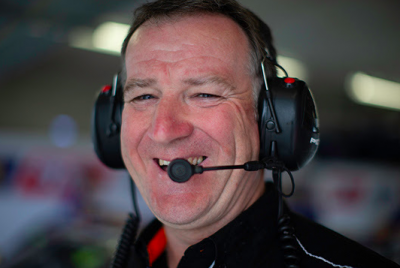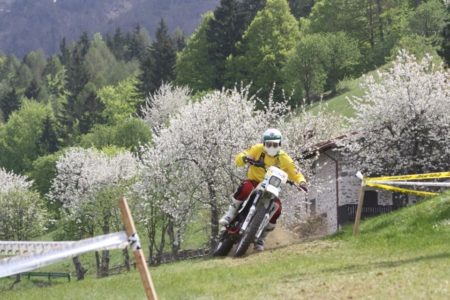

In a career that’s spanned the better part of three decades, David Stuart has represented Australia, worked his way from mechanic to engineer, and is now a key player in the motorsport’s administration.
Now working for Motorsport Australia, Stuart began his motorsport career as a competitor on two-wheels.
Growing up in the Blue Mountains, west of Sydney, he competed in trials and enduros.
Through school he’d hoped to be a builder, but a downturn in the economy saw the industry take a hit and instead he found himself spinning tools as an apprentice mechanic.
“None of my family are into Motorsport at all,” Stuart told Speedcafe.com.
“My brothers like cars, but they’re not into motorsport; my father was vehemently against me getting into Motorsport and so was my mother.
“In fact I went up and bought my first race bike when they went away on holiday, so they came back from holidays and there was a race bike in the shed.
“I was always really good with my hands, and I actually wanted to be a builder when I was at school, but when I was at school and in that position of leaving, the building industry was in a huge slump, so there were just no jobs out there, no apprenticeships.
“So I got an apprenticeship as a mechanic, and I really loved that mechanical side of things.
“The way things worked, understanding how they worked, the manufacturing of it.
“I was lucky and fortunate to do my apprenticeship in an engineering shop.
“We did everything; we manufactured things, and serviced cars, and built engines, and transmissions, and differentials and things like that, so I had a really good, broad based beginning, really.”
Shortly after finishing his apprentice, but still a teenager, Stuart was picked as a member of the Australian team for the International Six Day Enduro, the oldest off-road motorcycle event in the world.

He made two appearances in the event, as a Junior in 1985 and again in the Senior team in 1988.
“The thing about reliability trials or enduros as they’re called, is that the rider has to do all the work on the bike himself,” Stuart explained.
“If something breaks, there’s no service crew that can work on the bike, you have to carry your own tools, understand what’s gone wrong and repair that.
“Having done an apprenticeship as a mechanic gave me a really good understanding of how mechanical things work.”
In the early 90’s Stuart packed up life in Australia and headed to Europe where he worked with Peter Gallon in the 125cc Grand Prix Championship.
Prior to heading overseas Stuart had developed expertise when to came to a motorcycle’s suspension.
Electronics were really only just starting to come into the 500 class around this time,” he recalled.
”I developed quite a lot of skills with suspension, rebuilding and re-valving, so tuning the rear shock absorber and the forks on the motorcycle.
“I think that’s what kind of made it attractive.
“You had somebody that could rebuild an engine, understand gearing, and also tune the suspension.
“So in a small team, we didn’t have the luxury of having four or five mechanics, so it was just me.”
When his time in Europe came to a close Stuart returned to Australia and ultimately found his way to Ducati, campaigning in the Australian Superbike Championship.
There he developed new skills, branching out into electronics as he worked alongside Motec, remapping the engine map among other developments.
It was through that relationship that opened an opportunity to move to Dick Johnson Racing for 2000, where he quickly graduated to race engineer.
For the next nearly 20 years he worked for DJR or Stone Brother Racing (which latterly became Erebus Motorsport), and was instrumental in the development and homologation of the Mercedes-AMG E63 Supercar.
“We were very fortunate in that project that we were working with HWA, and to be able to sit down with their head of design who was pretty much the same as me, was a mechanic that worked for their DTM team and sort of grew up through their business to be the head of their design and build team,” Stuart said.
“We were able to converse on a really good level.
“We both had a very good understanding of how a car should be built and how things should be, so it was really beneficial.
“I think you’ve got to have a good foundation and a good base knowledge, and all of those people that you have spoken to, like Larry (Perkins) and Tim Edwards and Frank Lowndes especially, all of these people have a very good base knowledge of the mechanics of a vehicle.”
Stuart’s role now sees him a key player when it comes to the safety of Australian motorsport as Motorsport Australia’s Division Manager for Safety and Race Operations.

His task now is to ensure circuits in Australia and New Zealand operate to the highest safety levels, working alongside the likes of Tim Schencken and Michael Masi.
“As you get over you hopefully develop more experience and more understanding,” he explained.
“My role now is very minimal engineering but more around how race moving operates and very much focused on the safety installations in circuits.”
For Stuart, his background as a mechanic served him well, providing him with the underlying knowledge he’s used throughout his career ever since.
He’s also seen the role he once perform changed, with greater emphasis on individual expertise as opposed to a necessity for broad skillset.
“There’s a lot more people on the team now obviously, and there’s a lot of good guys in the supercars, a lot of good mechanics and they’ll go out of their way to have a better understanding.
“They’ll build up a good relationship with their race engineer and between the two of them they develop more; two people lifting is easier than one.
“So they develop a good understanding from a mechanics point of view, you develop a good understanding of the design kinematics of the car that the engineer is thinking about.
“From an engineer’s perspective, he gets a better understanding of how things fit together and what makes it easier.
“At the end of the day, good design should also make it easier for a mechanic to be able to change a damper quickly, or if they have an accident, be able to change the corner of the suspension quickly without having to fiddle around too much with odd sized bushings or things like that.
“When I first went to Dick Johnson Racing, a number one mechanic pretty much did everything on the car,” he added.
“They serviced the hubs, they serviced the uprights, probably didn’t do the gearboxes and diffs back then if I remember rightly, but they did a lot of hands on work.
“As the rules, and I can really only talk about Supercars, but as the rules around Supercars have developed and the control components come in there’s less of that type of work and teams expanded to have more specialty mechanics.
“So you’ll have a dedicated sub-assembly mechanic, but you’ve still got a mechanic pulling apart those components, inspecting the parts, and rebuilding them.
“You have to have that good base knowledge.”

While Stuart’s time as a race mechanic may have come to a close, privately he remains an enthusiast and continues to swing spanners.
“I’m still very much a two wheel guy,” he reasoned.
“I’ve got quite a few motorcycles in the garage, some fully restored and some in various states of restoration.
“I still love riding motorcycles, I still race competitively in what they call Vintage Veteran now, which is very undignified!
“I still have that very strong passion and connection to the two wheel side of things as well.
“I’ve got a 1982 Ducati Fantail which I did a ground up restoration on, which I’m very much in love with, just from being a really nice bike and the blood, sweat and tears that have gone into it, and I’m just about finished a 1986 KTM 250 dirt bike.
“The Ducati took a very long time because sometimes you’ve got the money but you don’t have the time, sometimes you’ve got the time and you don’t have the money, and sometimes you don’t have either.
“The KTM I really stripped over the Christmas holidays and just waiting for a few more bits to turn up to finish it off, so that’s a pretty quick one.”





















Discussion about this post